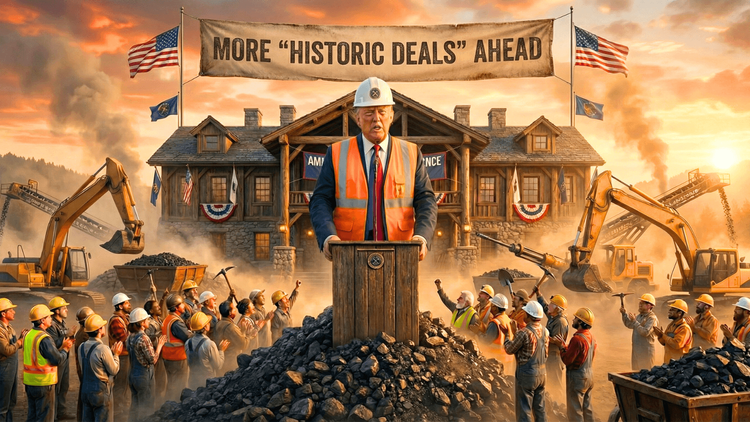Double Trouble: Trump Doubles Tariffs, Canada Doubles Down
U.S.-Canada Trade War Escalates as Trump’s Tariff Hike Sparks Economic and Political Backlash

President Donald Trump has announced a dramatic escalation in his trade war with Canada, declaring that tariffs on Canadian steel and aluminum will double to 50%. The move, set to take effect on March 12, 2025, follows Ontario’s decision to increase taxes on electricity exports to the United States. Trump's latest salvo against America’s closest trading partner marks another unpredictable shift in his aggressive trade policies.
A Sudden and Unprecedented Move
Trump’s decision, announced via social media, came as a shock to both policymakers and industry leaders. The initial 25% tariff on Canadian metals, which was already set to take effect, has now been doubled overnight. In addition, Trump threatened to “substantially increase” tariffs on Canadian auto parts by April 2 unless Canada eliminates tariffs on American dairy and other goods. He went so far as to claim that these measures could “permanently shut down the automobile manufacturing business in Canada.”
The timing of Trump’s announcement is particularly striking. It coincides with a volatile period for financial markets, which have been reacting negatively to his latest tariff policies. The S&P 500 dropped nearly 1% following the announcement, while the Dow Jones fell 1.4%. The Canadian dollar also took a hit, slipping to its lowest level in a week.
Trade War’s Impact on the Auto Industry
Trump’s threats to impose new tariffs on Canadian auto parts could deal a devastating blow to the North American auto sector. Canada’s automobile industry is deeply intertwined with that of the United States, with parts and vehicles crossing the border multiple times before reaching consumers. The president’s claim that these measures could shut down Canadian auto manufacturing is not an exaggeration—it could cripple the supply chain for major U.S. automakers as well.
In a move that stunned even trade analysts, Trump suggested that Canada should “become a part of the U.S.,” claiming that such a merger would eliminate tariffs and trade disputes altogether. While few in Washington take the idea seriously, it highlights the president’s unpredictable approach to economic policy.
Canada Strikes Back
Ontario Premier Doug Ford wasted no time in responding to Trump’s announcement. He stated that Ontario and Canada “will not back down until President Trump’s tariffs are gone for good.” The federal government in Ottawa has already signaled its willingness to retaliate. Among the measures being considered are a 25% surcharge on electricity exports to key U.S. states, including New York, Michigan, and Minnesota.
Canada has also imposed retaliatory tariffs on American products such as orange juice, footwear, and motorcycles. Ford, a prominent conservative figure in Canadian politics, lambasted Trump’s approach, arguing that his policies are harming both American and Canadian economies.
Energy Emergency and National Security
Trump’s declaration of an energy emergency has added another layer of complexity to the dispute. He has suggested using federal emergency powers to counter what he called an “abusive threat from Canada.” The administration could direct coal power plants to ramp up production or fast-track new energy projects to offset potential losses from Canadian electricity imports.
This move echoes Trump’s earlier declaration of a nationwide energy emergency on his first day in office, which enabled him to push through controversial infrastructure projects. By invoking similar powers now, he could accelerate the development of pipelines, power lines, and other projects to bypass Canadian energy supplies.
The Bigger Picture: U.S.-Canada Relations at a Crossroads
Trump’s escalating trade war with Canada has far-reaching consequences. Canada is the largest supplier of aluminum to the U.S., and increased tariffs will directly impact American manufacturers. Despite Trump’s rhetoric, his policies could backfire by raising costs for American businesses and consumers.
Markets have already reacted negatively to the trade tensions, with analysts warning that further escalation could trigger broader economic instability. While Trump has framed his policies as a way to protect American industry, critics argue that they are creating uncertainty and undermining North American trade stability.
With Canada on the verge of a leadership change, all eyes are on Mark Carney, the likely successor to Prime Minister Justin Trudeau. How Canada’s new government responds to Trump’s trade war will shape the future of U.S.-Canada relations for years to come.
Conclusion
Trump’s decision to double tariffs on Canadian steel and aluminum is a high-stakes gamble that could disrupt supply chains, shake financial markets, and strain diplomatic relations. While the president remains confident in his approach, the long-term consequences could be severe for both nations. As trade tensions escalate, businesses and policymakers on both sides of the border are bracing for a turbulent road ahead.






